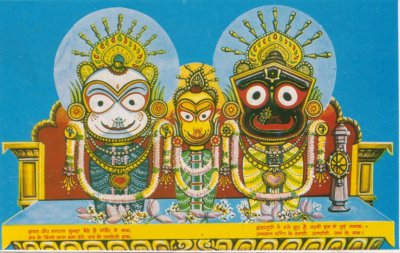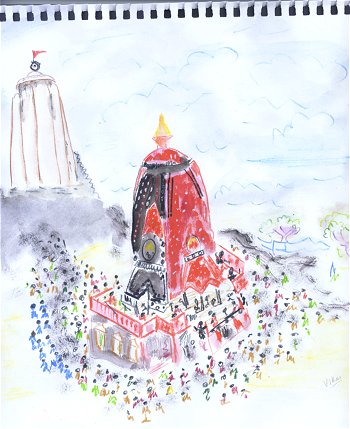Juggernaut of Puri
by Dr. (Mrs.) Jyotsna Kamat
First Online: February 7, 2003 in Amma's Column
Page Last Updated: December 07, 2024
Juggernaut the dictionary tells, is "any massive inexorable force that advances crushing whatever is in the path". The word has evolved from Jagannath, the diety of the famous shrine at Puri, which the British could not pronounce correctly. The car (ratha or chariot) of Jagannath is such an enormous and unwieldy construction that it requires thousands of people to pull it in procession.
The temple of Jagannath of Puri is situated in the state of Orissa in the Eastern Coast of India. The whole of eastern coast of India was populated with natives and the wooden image of Jagannath (a form of Lord Krishna) might originally have been a tribal shrine. Most of the tribal gods and monuments are wooden sculptures. The temple of Jagannath was constructed in the 12 the century by Choda Gangaraja (1078-1150 AD) of Eastern Ganga dynasty of Talakad and which is in present day Karnataka.
K.L. Kamat/Kamat's Potpourri
Idols of Balarama, Subhadra, and Krishna
Jagannath Temple, Puri
The main idols of this temple are Jagannath, his brother Balabhadra (a.k.a. Balarama) and his sister Subhadra- a peculiar trinity. The festival of Ashada ShuklaDwadashi (happens to be on July 11th of 2003) is dedicated to them. A very big festival or jatra takes place and hundreds and thousands of devotees through out the country assemble to pay respects. Three thousand priests help them in conducting the various rituals. The three rathas ( temple cars) built of various trees constructed in parts from traditional tools as was done thousands of years ago. Every year new Rathas are built and after the festival they are dismembered. The parts are later used to make wooden artifacts.
There is no untouchability in the temple premises. Poorest and the downtrodden can freely worship and offer the humble fare of khichadi to Lord Jagannath in earthen pots. This is the universal offering in this temple. This free and open entry has given room to the belief that formerly Jagannath was a Buddhist shrine representing Buddha, Dharma and Sangha- The Buddhist Holy Trinity. A small casket supposed to contain asthi (ashes) of Lord Krishna is inserted in the wooden body of Jagannath every twelve years, again confirming the guess that earlier it could have been a Buddhist stupa, containing holy relics of Buddha. True to Hindu tradition of Pantheon, known to absorb all cults and practices of other faiths with variations, tenets of Buddhism might have been amalgamated along with tribal traits. This idea must have been at the root of the Trinity of Krishna, his brother and sister.
© Vikas Kamat

The Rathotsavam (or driving of chariots) of Jagannath from the temple to sea beach is a distance of two miles. It's a mammoth affair indeed of three huge and strong rathas with sixteen, fourteen and twelve wheels made for the occasion drawn specially at this time. It must be an Herculean task!
Gandhiji rightly observed that places of pilgrimage in four corners of India kept the countrymen together. These shrines common to all Hindus made them travel long distances, to interact with local people, forgetting the entire strain and travails of the entire journey. People offered heartfelt gratitude to each different deity in their own way.
![]()
See Also:
- Temples on Wheels -- Pictorial exhibition of the car festivals of India; some cars these!
- Exploits of Krishna -- Depiction of life of Lord Krishna in Indian art and mythology; includes a number of pictures from Krishnaleela.

